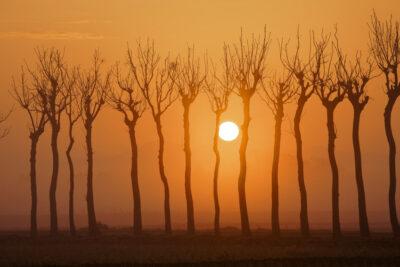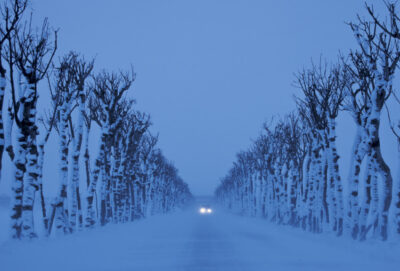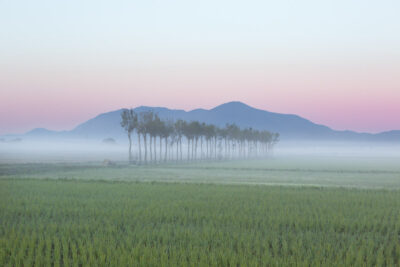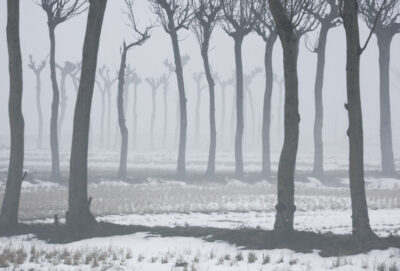
ハザ木は農業文化の火焔型土器
朝夕の気温が下がり始める初秋、新潟平野の広々とした田園にも、時折霧が立ち込めます。霧の中から朝日が昇ると、ハザ木の真ん中を十字に仕切る畔にたたずむ人影が、どこか新潟版ミレーの農夫を思わせます。周囲の田んぼではコシヒカリが風に倒されているものの、もともと倒伏に強い品種のため、この気温差がむしろ米の味を一層引き立ててくれるのだそうです。
この写真はかなり前に撮影したものですが、残念なことに、オブジェのように美しく並んでいた一列のハザ木は、すでに刈り取られてしまいました。新潟県内の過去のハザ木の分布に関しての文献があるのかどうか調べてはいませんが、おそらく今残っているハザ木の量を考えると、弥彦山や角田山などが見える西蒲原の地域に多かったのだろうと思います。新潟平野に点在するこれらのハザ木の群れは、ほぼ新潟県内にしか見られないという点で、火焔型土器の分布などと共に新潟の地域色のひとつです。
稲を天日で干す必要が少なくなった現在では無用の長物になってしまいましたが、厳しい自然と向き合い築かれた独自の文化や風土が、新潟の土地には共通して息づいているように思います。
As the temperatures begin to drop in the early autumn, mist occasionally rolls in over the vast farmlands of the Niigata Plain. When the morning sun rises through the mist, the silhouette of a person standing on the ridge that divides the hazaki trees in the middle of the field is reminiscent of Millet’s peasant farmers in Niigata. In the surrounding rice fields, the Koshihikari rice plants are being blown over by the wind, but since this variety is naturally resistant to lodging, the temperature difference actually enhances the flavor of the rice, apparently.
This photo was taken quite some time ago, but unfortunately, the row of hazaki trees that once stood beautifully like objects of art has already been cut down. I have not researched whether there are any documents regarding the past distribution of haze trees in Niigata Prefecture, but considering the number of haze trees remaining today, I think they were once more prevalent in the Nishikanbara region, where Mount Yahiko and Mount Kakuda can be seen. These clusters of haze trees scattered across the Niigata Plain are unique to Niigata Prefecture, making them one of the region’s distinctive features, alongside the distribution of flame-shaped pottery.
Although they have become obsolete in today’s world where there is little need to dry rice in the sun, the unique culture and landscape shaped by the harsh natural environment continue to thrive in the land of Niigata.
PENTAX67 200mm
©️photo by Nakamura Osamu



